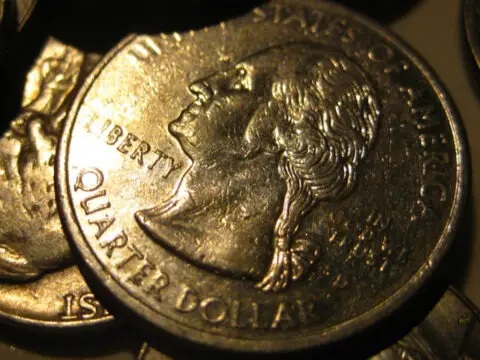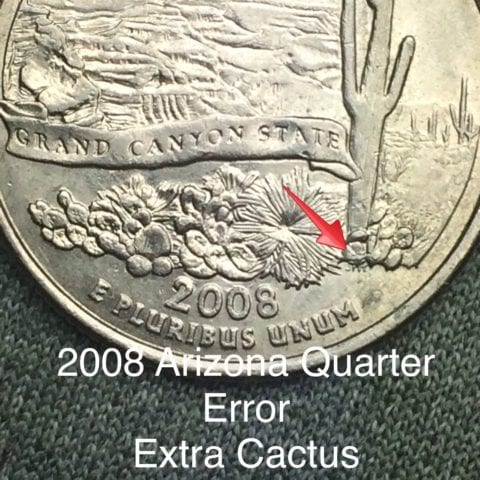Have you heard about the errors that exist on 2008 Arizona quarters?
It’s true. If you have an Arizona quarter error coin, it could be worth $5… or more!
Some 2008 Arizona quarters have an extra cactus leaf — a really cool error caused by a die break.
What does the cactus error look like?
How much is this Arizona quarter error worth?
Are there any other Arizona state quarter errors worth looking for?
Today I’m going to tell you how to find this valuable Arizona quarter error (and others) in your pocket change or in bank rolls…
How To Spot The Extra Cactus Leaf Error
Some 2008-P Arizona quarters struck at the Philadelphia Mint have a die crack in the cactus leaves — toward the bottom of the tall cacti on the right side of the “tails” (reverse) design.
The die crack cuts horizontally across the lower leaf that covers the bottom of the tall cacti’s trunk, giving the appearance of an extra cactus leaf.
Watch this video for more info about the extra cactus leaf Arizona quarter error:
How Much Is The Extra Leaf Arizona Quarter Error Worth?
When the 2008 Arizona quarter error was first discovered, some collectors were spending more than $100 for it!
A lot of time has passed since these error coins were first found and there’s less demand for them today — but it’s still a cool coin to collect.
These days, the Arizona quarter extra leaf error is selling for about $3 to $5. Your Arizona extra cactus leaf quarter may be worth more or less, depending on the condition of your individual coin.
Other Arizona Quarter Errors
The extra cactus leaf quarter is just one type of Arizona quarter error — there are others. While some are pretty common, they’re all fascinating and worthwhile collectible coins.
Here are a few types of 2008 Arizona quarter errors and varieties to look for:
- Off-center Arizona quarter — Depending on how far off center the strike is, the coin might be worth a dollar or two, on the low end. On the high end, it could be worth $100 or more. Generally speaking, a coin must be at least 5% to 10% or more off center for it to be worth any extra money.
- Arizona quarter with die chips — Die chips are little raised chunks of metal on the coin’s surface that alter the design. The blobs can be large or small. They’re often seen near the edges of the design, in and around lettering and numerals, or near other devices. A popular Arizona quarter error has die chips over the initials of the designer and engraver on the reverse of the quarter. It’s worth $5 to $10. Other Arizona quarters with prominent die chips can be worth $3 to $5… or more.
- Arizona quarter with “Spiked A” — This cool variety has a die crack running through the second “A” in “ARIZONA,” giving the second “A” the appearance of a spike going through the letter. These are trading for around $2 to $4 — sometimes more, depending on the condition of the coin.
Here are some examples of the coin errors described above.
2008 Arizona Quarter Facts & Trivia
Arizona quarters — even regular ones without errors — are awesome coins to add to your collection!
Here’s some interesting info about these 2008 quarters, including what you see in the elaborate nature-themed design, how many Arizona quarters were made, who designed them, and more:
- More than half a billion Arizona quarters were struck. Of the circulating business strikes, 251,800,000 were struck at the Philadelphia Mint and 254,000,000 were made at the Denver Mint. More than 3 million proof Arizona quarters were produced at the San Francisco Mint — including 2,078,112 clad proofs and 1,192,908 silver proofs.
- The 50 State Quarters program, which the Arizona quarter belongs to, was in production from 1999 through 2008. It was one of the most popular and ambitious United States coin initiatives ever. At one point in the 2000s, the U.S. Mint estimated that more than 100 million people were collecting state quarters!
- The 2008 Arizona quarter was designed by Artistic Infusion Program Master Designer Joel Iskowitz and engraved by United States Mint Sculptor-Engraver Joseph Menna.
- The 2008 Arizona state quarter design features a Saguaro cactus in the foreground and the Grand Canyon in the background. There’s also a banner running across the lower left side of the reverse that reads “Grand Canyon State.” The inscription “1912” on the coin signifies the year that Arizona was admitted into the Union as the nation’s 48th state.
- The Grand Canyon, which plays a starring role on the Arizona quarter, was carved over millions of years by the Colorado River and is more than 6,000 feet deep and up to 18 miles wide. The Grand Canyon is visited by some 4 million people each year and is one of the most photographed natural landmarks in the world.
- The Saguaro cactus is one of the most recognizable plants in the American Southwest. They can grow more than 40 feet tall and live 150 years. The Saguaro cactus usually won’t begin growing arms until its older than 75 years of age.
Other State Quarter Errors To Look For
In addition to the Arizona quarter errors mentioned above, here are some of our other articles about U.S. quarters with errors:
- See How Much The 1999 Delaware Quarter Error Is Worth
- The Minnesota Quarter Error Is Worth Big Bucks & Can Be Found In Pocket Change
- Wisconsin Error Quarters — Look For The Extra Leaf
- Have A 2007 Wyoming Quarter? It Could Be Worth $25 Or More
- 3 Rare Kansas Error Quarters To Look For!
- 50 State Quarters Values, Errors, And Little-Known Facts About The State Quarters







